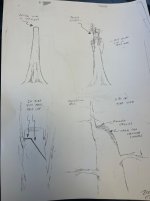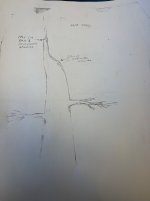Stickymatch
Seed
Long time lurker and reader but first time posting.
I've been keeping indoor bonsai (ficus, jade, schefflera, etc.), off and on, for a number of years but never very seriously due to other hobbies and mostly already "trained" plants that I just kept trimmed as time presented itself. I learned some but honestly wasn't the best steward.
As I've aged and other hobbies have come and gone I keep getting drawn back to bonsai and the desire to learn more and challenge myself.
I have zero experience with outdoor trees for bonsai and was just gifted this beautiful Amber Glow Dawn Redwood due to an overbuy for a landscaping project. It's about 6.5' tall, trunk is 1" in diameter and currently in a 5-gal nursery pot. I'm in Zone 6b for reference.
Ultimate goals are to have a 3-4' tall formal style (probably ambitious). I know this will take some time and while l'm in no rush, if there are methods to speed up the process, I'm willing to learn and understand the pros and cons. I just want to learn and have fun.
So...what's the best way to thicken the trunk on these? Planting in the ground is currently not an option so containers will have to be the focus in the short term. Everything I've read says larger pots but l'm confused on size and frequency of repotting. What's the recommended size to go to from this 5 gal nursery pot? How long will it stay in that pot (2 years)? What pruning needs to be done during this time as I don't think you'd want to cut it down yet, right? In addition, what's the best soil to use for container growing?
Any info is appreciate and thanks for taking the time to read.

I've been keeping indoor bonsai (ficus, jade, schefflera, etc.), off and on, for a number of years but never very seriously due to other hobbies and mostly already "trained" plants that I just kept trimmed as time presented itself. I learned some but honestly wasn't the best steward.
As I've aged and other hobbies have come and gone I keep getting drawn back to bonsai and the desire to learn more and challenge myself.
I have zero experience with outdoor trees for bonsai and was just gifted this beautiful Amber Glow Dawn Redwood due to an overbuy for a landscaping project. It's about 6.5' tall, trunk is 1" in diameter and currently in a 5-gal nursery pot. I'm in Zone 6b for reference.
Ultimate goals are to have a 3-4' tall formal style (probably ambitious). I know this will take some time and while l'm in no rush, if there are methods to speed up the process, I'm willing to learn and understand the pros and cons. I just want to learn and have fun.
So...what's the best way to thicken the trunk on these? Planting in the ground is currently not an option so containers will have to be the focus in the short term. Everything I've read says larger pots but l'm confused on size and frequency of repotting. What's the recommended size to go to from this 5 gal nursery pot? How long will it stay in that pot (2 years)? What pruning needs to be done during this time as I don't think you'd want to cut it down yet, right? In addition, what's the best soil to use for container growing?
Any info is appreciate and thanks for taking the time to read.




